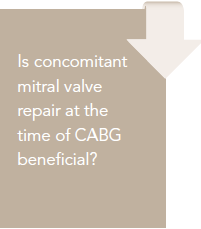Publication
Article
Surgical Treatment of Moderate Ischemic Mitral Regurgitation
Author(s):
The addition of a mitral valve repair to patients undergoing coronary artery bypass graft (CABG) surgery with moderate ischemic mitral regurgitation is still a source of controversy. Recent guidelines state that concomitant mitral valve repair at the time of CABG may be beneficial, but the evidence is inconclusive.

Harold L. Lazar, MD
Review
Smith PK, Puskas JD, Ascheim DD, et al; for the Cardiothoracic Surgical Trials Network Investigators. Surgical treatment of moderate ischemic mitral regurgitation. N Engl J Med. 2014;371:2178-2188.

The addition of a mitral valve repair to patients undergoing coronary artery bypass graft (CABG) surgery with moderate ischemic mitral regurgitation is still a source of controversy. Recent guidelines state that concomitant mitral valve repair at the time of CABG may be beneficial, but the evidence is inconclusive.1
Study Details
In order to further define the role of mitral valve repair in patients undergoing CABG surgery with moderate ischemic mitral regurgitation, Smith and coworkers performed a prospective randomized study in 301 patients from 26 centers in the Cardiothoracic Surgical Trials Network.2 The degree of mitral regurgitaiton was assessed preoperatively using transthoracic echocardiography. The primary endpoint was changes in left ventricular end-systolic volume index (LVESVI), a surrogate for LV remodeling, 1 year following surgery. All patients received a complete annuloplasty ring. The selection of ring types and implantation technique was left to the discretion of the operating surgeon.
After 1 year there was no difference in LVESVI or death rate between the groups. Mitral valve repair, however, was associated with longer cardiopulmonary bypass times, longer hospital stay, a higher incidence of supraventricular arrhythmias, and more neurological events immediately following surgery. After 1 year, there was no difference in major cardiovascular events, strokes, readmissions, or changes in quality of life between the groups; however, the incidence of moderate or severe mitral regurgitation was less common in the mitral valve-CABG patients.
Commentary
At 1 year, no clinically meaningful advantage of adding mitral-valve repair to CABG
Several limitations in the study restrict the conclusions that can be drawn. The follow-up period was relatively short—only 1 year. Fattouch and colleagues showed a decrease in LVSWI and mitral regurgitation and other indices of reverse remodeling and improved NYHA functional class with CABG and mitral valve repair after an average of 32 months.3 Furthermore, in the current trial, at 1 year the proportion of patients with residual mitral regurgitation was significantly lower in the CABG plus mitral valve repair group. This might have resulted in better long-term clinical outcomes as well as better LV remodeling had this study been continued for a longer period of time.
In fact, Acker and coworkers, in a recent study from the Cardiothoracic Surgical Trials Network, showed that mitral valve procedures that reduced recurrent mitral regurgitation will have a significant improvement in LVESWI over time.4 In the current trial, 89% of patients in the CABG and mitral valve repair group had no or mild mitral regurgitation at 1 year compared with 69% in the CABG group. With time, this difference in mitral regurgitation may have resulted in better clinical outcomes in the CABG and mitral repair group.
As shown in earlier studies, the ability to eliminate ischemic mitral regurgitation is determined by the nature of the mitral regurgitation jet. Central mitral regurgitation due to LV and mitral annular dilatation is best treated by a complete rigid annuloplasty ring that is downsized from the distance measured between the anterior trigones; however, if the mitral regurgitation is due to a regional wall motion abnormality that results in displacement of the papillary muscles and leaflet tethering, then other techniques such as chord-cutting or the use of NeoChords to realign the leaflets for better coaptation will be necessary. In this trial, no mention is made as to the characteristics of the mitral jet orwhether it was due to mitral annular dilatation or leaflet tethering.
Finally, we are not told what proportion of patients of the group received postoperative angiotensin-converting enzyme inhibitors or other antihypertensive medication, statins, and beta-blockers, all of which could have affected LVSWI measurements.
What, then, can we conclude from this study that is relevant to our clinical practices? CABG alone may be all that is necessary for patients with coronary artery disease and moderate ischemic mitral regurgitation. None of the patients in this group required another mitral procedure in the 1 year follow-up period, and 69% had only minimal mitral regurgitation during this time; however, before any definitive conclusions or guidelines can be made regarding this group of patients, a larger trial, significantly powered to assess clinical endpoints over at least a 3-year period, will be necessary. Only then can we determine the best strategy for patients who require CABG surgery and have concomitant moderate ischemic mitral regurgitation.
References
1. Ishimura RA, OhoCM, Bonow RO, et al. 2014 AHA/ACC guidelines for the management of patients for valvular heart disease: a report of the American College of Cardiology/American Heart Association Task Force on practical guidelines. J Am Coll Cardiol.2014;63:e57-e185.
2. Smith PK, Puskas DD, Aschein P, et al. Surgical treatment of moderate ischemic mitral regurgitation. N Engl J Med. 2014;371:2178-2188.
3. Fattouch K, Guccione F, Sampougnaro R, et al. Efficacy of adding mitral valve restrictive annuloplasty to coronary artery bypass grafting in patients with moderate ischemic mitral valve regurgitation.J Thoracic Cardiovasc Surg. 2009;138:278-185.
4. Acker MA, Parides MK, Perrault LP, et al. Mitral-valve repair versus replacement for severe ischemic mitral regurgitation. N Engl J Med. 2014;370:23-32.
About the Author
Harold L. Lazar, MD, is professor of cardiothoracic surgery at Boston University School of Medicine and the Boston Medical Center, Boston, MA. He received his MD from Boston University, completed his residency in general surgery at the University of Michigan Medical Center in Ann Arbor, and did his cardiothoracic residency at Columbia-Presbyterian Medical Center in New York. Dr Lazar has lectured widely and is the author of numerous journal articles and book chapters. He is editor in chief of The Journal of Cardiac Surgery.






